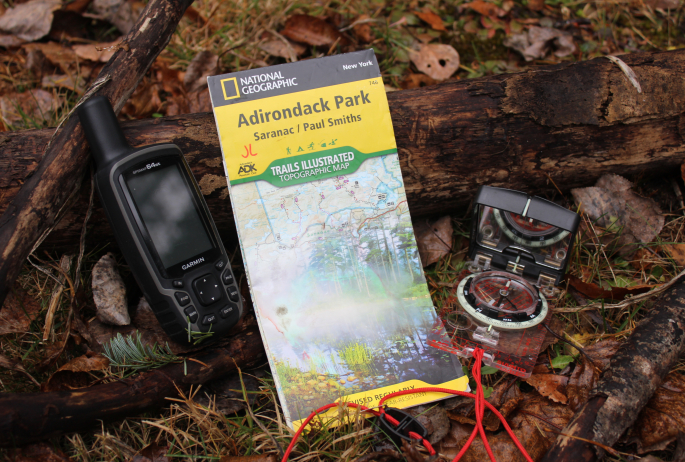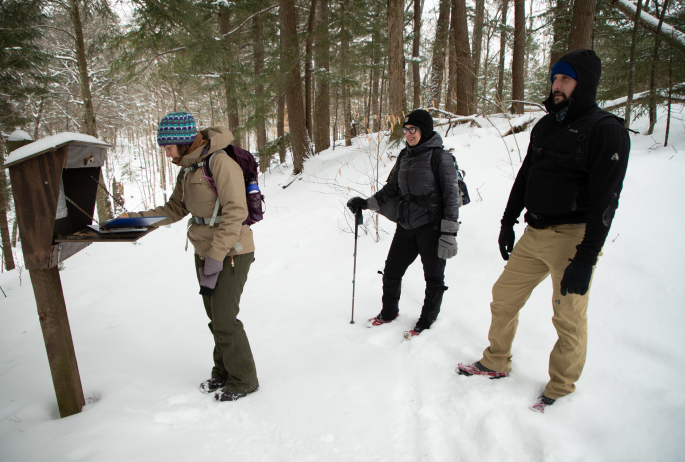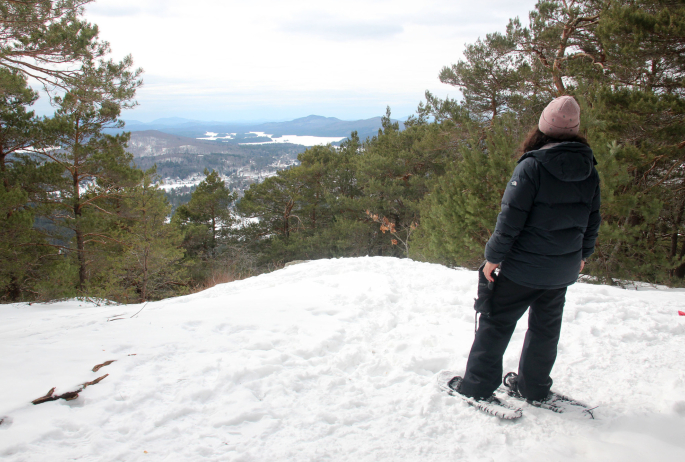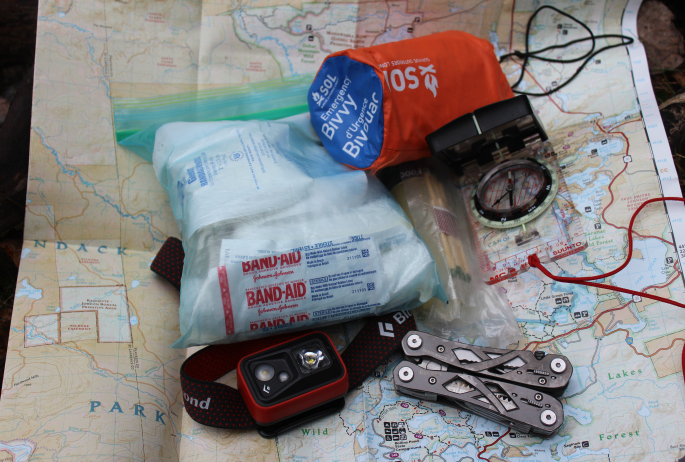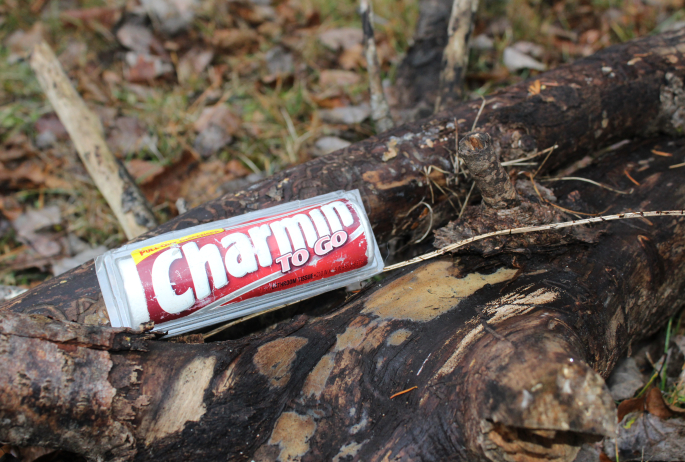Winter hiking and snowshoeing can open a whole new world to those adventurous enough to get out on the trails! With no leaves on the trees, new views appear on familiar trails; low humidity extends mountaintop vistas, and snow and ice add a dazzling glimmer to the landscape.
Regardless of the time of year, Saranac Lake offers exciting ways to explore the mountains and other low-elevation hikes in and around Saranac Lake. From the approachable trail system at Paul Smith's College VIC or the Bloomingdale Bog Trail, to more remote and challenging hikes like Ampersand and Mt. McKenzie, each hike has its own personality and perks.

So whether you’re hiking Mount Baker or McKenzie, St. Regis or Scarface, a newbie or experienced hiker, it pays to pay attention to the details and be prepared for whatever your adventure entails!
Plan ahead
There are a few steps to be taken before any backcountry adventure, and the first ones take place before you ever leave home.
First, research your hike by using maps and reliable websites like the state Department of Environmental Conservation’s. While apps like AllTrails can be helpful, the content is all user generated and may not be the most accurate, so don’t rely on the advice of random internet folks - take a look for yourself and read what the experts say. Furthermore, you should plan for winter conditions regardless of the weather in town. It might be a relatively warm winter day with little snow cover, but the trail may be a different story. Trails are often icy and packed with snow, even if there's been a thaw. So it's a good idea to be prepared with extra layers, spikes or cramp-ons, and other winter hiking gear (which can be rented from several local outfitters).

Second, make an itinerary and leave it with someone responsible. Again, random internet people aren’t the most reliable, so don’t leave a vague post on Facebook and hope that this is enough. Call, text, or email someone who is invested in your safety, and let them know where you’re going and when to expect you back. You can also give them the DEC’s phone number to call in case something does happen: (518) 891-0235.
Third, pick a couple of possible destinations in case your main one is too busy. Nothing ruins a hike like coming back to find your car ticketed because you parked illegally. If the trailhead is full, move on to your second choice. The mountains will be there, but your car may not be.

Finally, be sure to sign in at the trail register before beginning your adventure. Not only does it provide valuable information for search and rescue, it helps the DEC know how many people are going to each location in the Adirondacks, and compiles important usage information for planning purposes.
10 Essentials
Winter hiking has different views and rewards, but also comes with a number of challenges. Shorter days, colder temperatures, and the added difficulty of navigating snow and ice all mean that an extra amount of caution and preparedness should be taken. On top of that, the weather and temperatures can be completely different from the trailhead to the summit - so bring anything you might need, rather than trying to get away with bringing the bare minimum. As they say "it's better to have it and not need it, then to need it and not have it."

You’ve probably heard of the “10 Essentials,” so named because they are actually essential to have with you. The essentials are grouped into 10 categories and include items such as map and compass, headlamp, first aid kit, extra clothes, water, and food, and fire-starting equipment. All told, it’s not a lot to carry, but it could mean the difference between being slightly uncomfortable and needing an ambulance.
Check out the 10 Essentials here, and don’t forget that even in winter things like sunglasses may be necessary.
Don’t rely on a cell
When I was a kid, (walking uphill both ways to and from school), my teachers said, “you’re not going to be carrying around a calculator all the time” in an effort to get me to learn how to do math. Well, the joke’s on them! Because I now not only have a calculator with me at all times, but also a camera, map, flashlight, and the cumulative knowledge of humanity at my fingertips at all times.
But in the backcountry, my cell phone may as well be dead weight. Or at least I view it that way when getting ready for a hike, snowshoe, or ski. While it may be tempting to rely on this amazing device, there are lots of hurdles to its effective use and that is why you should have a map and compass, leave an itinerary, and bring a flashlight or headlamp with you.
In the Adirondacks, finding good cell service outside of town is about as likely as seeing Bigfoot. On top of that, the constant search for networks, the cold temperatures, and the general remoteness and rugged nature of most hiking destinations means that cell phones are more likely to fail or be essentially useless. That’s not to say you shouldn’t bring your phone, just don’t rely on it as your primary source of navigation or light.
Poop properly
Listen, there’s no getting around it. We can’t just dump this topic, and there’s no point in flushing this advice down the drain. Sure, it stinks, but everybody poops. They even wrote a kid’s book about it!
Perhaps the easiest way to handle everyone’s favorite palindrome while hiking is to hit the head before hitting the trail. Plenty of local businesses in Saranac Lake have not only snacks, coffee, and drinks that can keep you fueled up, but their bathrooms are also open for use.

However, sometimes nature strikes while you’re out on the trail. There are hundreds of outhouses scattered around the Adirondacks in often convenient locations, so if there’s no indoor plumbing, check for spiders and do your thing.
But if there’s no bathroom or outhouse nearby, make like a bear and poop in the woods. Just be sure to stay at least 200 feet from trails, campsites, roads, streams, and ponds. Basically, 200 feet from water and anywhere other people might be. If you don’t feel like measuring, take about 70 large steps and for most adults that will be about 200 feet. But your duty isn’t done there. First, dig a small hole about 8 inches deep, drop the kids off at the pool, and then cover it back up.
Love Your ADK
If you plan on adventuring - whether it’s climbing the local mountains, skiing into a remote pond, or snowshoeing to an amazing view, be sure to pledge to Love Your ADK. Based on the seven Leave No Trace principles, the Love Your ADK pledge means that you will leave the Adirondacks a better place than you found them. Join thousands of people who have taken the pledge, and take the pledge yourself today!









